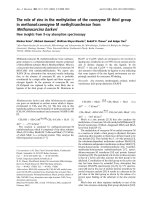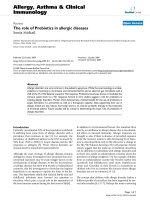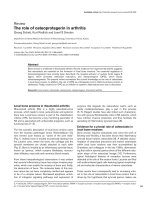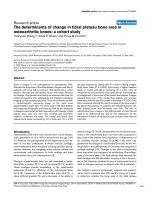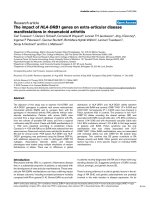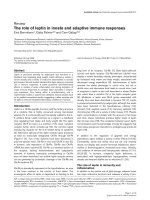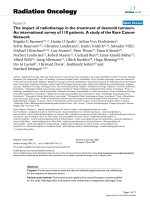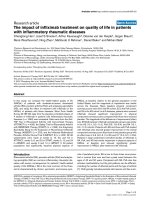Báo cáo y học: "The impact of infliximab treatment on quality of life in patients with inflammatory rheumatic diseases" ppsx
Bạn đang xem bản rút gọn của tài liệu. Xem và tải ngay bản đầy đủ của tài liệu tại đây (530.38 KB, 6 trang )
Open Access
Available online />Page 1 of 6
(page number not for citation purposes)
Vol 9 No 5
Research article
The impact of infliximab treatment on quality of life in patients
with inflammatory rheumatic diseases
Chenglong Han
1
, Josef S Smolen
2
, Arthur Kavanaugh
3
, Désirée van der Heijde
4
, Jürgen Braun
5
,
René Westhovens
6
, Ning Zhao
1
, Mahboob U Rahman
1
, Daniel Baker
1
and Mohan Bala
1
1
Centocor Research and Development, Inc., 200 Great Valley Parkway, Malvern, Pennsylvania, 19355 USA
2
Division of Rheumatology, Internal Medicine III, Medical University of Vienna and Hietzing Hospital, Waehringer Guertel 18-20, A-1090, Vienna,
Austria
3
Division of Rheumatology, Allergy, and Immunology, University of California, San Diego, 9500 Gilman Drive, LaJolla, California, 92093 USA
4
Department of Rheumatology, Leiden University Medical Center, PO Box 9600, 2300 RC Leiden, The Netherlands
5
Rheumazentrum Ruhrgebiet, Landgrafenstrasse 15, D-44652 Herne, Germany
6
Division of Rheumatology, UZ Gasthuisberg, Herestraat 49, 3000 Leuven, Belgium
Corresponding author: Chenglong Han,
Received: 30 Mar 2007 Revisions requested: 25 May 2007 Revisions received: 16 Aug 2007 Accepted: 8 Oct 2007 Published: 8 Oct 2007
Arthritis Research & Therapy 2007, 9:R103 (doi:10.1186/ar2306)
This article is online at: />© 2007 Chenglong Han et al.; licensee BioMed Central Ltd.
This is an open access article distributed under the terms of the Creative Commons Attribution License ( />),
which permits unrestricted use, distribution, and reproduction in any medium, provided the original work is properly cited.
Abstract
In this study, we compare the health-related quality of life
(HRQoL) of patients with moderate-to-severe rheumatoid
arthritis (RA), psoriatic arthritis (PsA), and ankylosing spondylitis
(AS), and study the effect of treatment with infliximab on the
HRQoL of patients with these diseases. Short Form Health
Survey-36 (SF-36) data from the placebo-controlled phases of
4 studies of infliximab in patients with inflammatory rheumatic
diseases (n = 1990) were evaluated. Data came from the Anti-
TNF Trial in Rheumatoid Arthritis with Concomitant Therapy
(ATTRACT) (n = 428), the Safety Trial for Rheumatoid Arthritis
with REMICADE Therapy (START) (n = 1083), the Ankylosing
Spondylitis Study for the Evaluation of Recombinant Infliximab
Therapy (ASSERT) (n = 279), and the Infliximab Multinational
Psoriatic Arthritis Clinical Trial II (IMPACT II) (n = 200). SF-36
assessments were made at weeks 0, 10, 30, and 54 in
ATTRACT, weeks 0, 6, and 22 in START, weeks 0, 12, and 24
in ASSERT, and weeks 0 and 14 in IMPACT II. All patient
populations had significantly impaired physical aspects of
HRQoL at baseline relative to the general population of the
United States, and the magnitude of impairment was similar
across the diseases. Mean baseline physical component
summary scores were 29 in the RA cohort, 32 in the PsA cohort,
and 29 in the AS cohort. In all 3 diseases, patients who received
infliximab showed significant improvement in physical
component summary scores compared with those who received
placebo. The magnitude of the difference of improvement (effect
size, 95%CI) between infliximab and placebo groups was similar
in the AS (10.1, 9.2–11.0), PsA (8.6, 7.8–9.4), and RA (10.1,
9.2–11.0) cohorts. Patients with RA and those with PsA treated
with infliximab also showed greater improvement in the mental
component summary score than those in the placebo group with
an effect size of 4.6 (4.2–5.1) in RA and 2.7 (2.4–3.1) in PsA.
Patients in large randomized controlled studies of infliximab in
RA, PsA, and AS had similar impairment in physical aspects of
HRQoL at baseline and showed significantly greater
improvement in HRQoL after treatment with infliximab.
Introduction
Rheumatoid arthritis (RA), psoriatic arthritis (PsA) and ankylos-
ing spondylitis (AS) are common inflammatory rheumatic dis-
eases with severe consequences for patients' health-related
quality of life (HRQoL). RA is the most common of the three,
and is characterized by chronic, symmetric, and erosive syno-
vitis of peripheral joints. RA is two to three times more preva-
lent in women than men and has a peak onset between the
ages of 40 and 50 years. Compared with RA, PsA also has
articular manifestations, but the joint patterns can be different,
including the number of affected joints and the type of arthritis
[1]. PsA typically includes psoriatic skin lesions and has a sim-
ANCOVA = analysis of covariance; AS = ankylosing spondylitis; ASSERT = Ankylosing Spondylitis Study for the Evaluation of Recombinant Infliximab
Therapy; ATTRACT = Anti-TNF Trial in Rheumatoid Arthritis with Concomitant Therapy; CRP = C-reactive protein; HRQoL = health-related quality of
life; IMPACT II = Infliximab Multinational Psoriatic Arthritis Clinical Trial II; MCS = mental component summary score; MTX = methotrexate; PsA =
psoriatic arthritis; PCS = physical component summary score; RA = rheumatoid arthritis; SF-36 = Short Form Health Survey-36; START = Safety
Trial for Rheumatoid Arthritis with REMICADE Therapy; TNF = tumor necrosis factor.
Arthritis Research & Therapy Vol 9 No 5 Han et al.
Page 2 of 6
(page number not for citation purposes)
ilar prevalence in men and women. Patients with PsA are also
usually affected at a younger age than those with RA. Both RA
and PsA can lead to impaired function and reduced mobility.
AS predominantly affects the axial skeleton and sacroiliac
joints (sacroiliitis), which typically leads to decreased spinal
mobility. However, AS may also include extraspinal manifesta-
tions, such as peripheral arthritis and uveitis, and it is often
associated with inflammatory bowel disease and psoriasis. In
contrast to RA, AS is three times more prevalent in men than
women, and symptoms usually begin in adolescence.
Daily pain, stiffness, fatigue, and physical disability are com-
mon features of all three rheumatic diseases. Persistent active
disease without effective treatment may lead to permanent
loss of physical function, reduced productivity, and increased
rates of work disability about 10 years after disease onset [2].
Impairments in physical functioning and disability, and the
strategies patients use to cope with them, can significantly
affect HRQoL. Traditionally, RA is considered to be the most
severe of the three diseases, exerting the greatest impact on
physical aspects of HRQoL. However, the cohorts of previous
studies that compared the HRQoL of patients with RA to that
of patients with PsA or AS consisted primarily of patients with
mild-to-moderate disease [3,4]. Disease severity is an impor-
tant factor influencing the HRQoL of patients. Therefore, the
objectives of this study were to compare the HRQoL of
patients with moderate-to-severe RA, PsA, or AS, and to com-
pare the effect of treatment with infliximab on the HRQoL of
patients with these diseases.
Materials and methods
This analysis included 1,987 patients from four clinical trials in
which the safety and efficacy of infliximab was evaluated in
rheumatic diseases. Two of the trials were conducted in
patients with RA: the Anti-TNF Trial in Rheumatoid Arthritis
with Concomitant Therapy (ATTRACT) (n = 428) [5-7] and the
Safety Trial for Rheumatoid Arthritis with REMICADE Therapy
(START) (n = 1083) [8]. The disease severity entry criteria for
these studies were similar. All patients must have had active
RA with 6 or more tender and swollen joints. In ATTRACT,
patients must have also had two or more of the following:
morning stiffness ≥45 minutes, erythrocyte sedimentation rate
>28 mm/hour, and C-reactive protein >2 mg/dL. Patients in
both studies must have demonstrated these symptoms
despite receiving stable doses of MTX (≥12.5 mg/week for
patients in ATTRACT). Patients in ATTRACT were not permit-
ted to have significant comorbidities or concomitant medica-
tions, whereas patients were permitted in START as long as
they did not have conditions or concomitant medications that
were prohibited by the product labeling.
Data from the Ankylosing Spondylitis Study for the Evaluation
of Recombinant Infliximab Therapy (ASSERT) (n = 279) were
used to assess HRQoL in AS [9], and data from the Infliximab
Multinational Psoriatic Arthritis Clinical Trial II (IMPACT II) (n =
200) [1] were used to assess HRQoL in PsA. Patients were
eligible for the ASSERT study if they had a Bath Ankylosing
Spondylitis Disease Activity Index score of ≥4 (range 0 to 10)
and a spinal pain assessment score of ≥4 on a visual analog
scale (range 0 to 10). Patients were eligible for the IMPACT II
study if they had ≥5 tender and ≥5 swollen joints and either
CRP levels of ≥15 mg/L and/or morning stiffness lasting ≥45
minutes.
All studies were conducted at multiple study sites in North
America and Europe. The START study was also conducted at
sites in South America.
Detailed descriptions of patient selection criteria and study
designs for these trials have been published elsewhere [5-10].
As indicated in these reports, all studies were conducted in
compliance with the Declaration of Helsinki, and all patients
gave written informed consent to participate in the study. The
impact of treatment on the HRQoL of patients in the ATTRACT
[6] and IMPACT II [11] studies have also been published pre-
viously. In each study, patients were randomly assigned to
receive either infliximab or placebo in a 3-dose induction regi-
men followed by maintenance therapy. Patients in ATTRACT
received infliximab at 3 mg per kg of body weight or 10 mg per
kg of body weight every 4 or 8 weeks, patients in START
received infliximab at 3 mg per kg body weight or 10 mg per
kg body weight every 8 weeks, patients in ASSERT received
5 mg per kg body weight every 6 weeks, and patients in
IMPACT II received 5 mg per kg body weight every 8 weeks.
All patients in RA clinical trials received concomitant meth-
otrexate (MTX). Patients in IMPACT II were allowed to con-
tinue therapy with stable doses of MTX if they were receiving
it at baseline. None of the patients in ASSERT received con-
comitant MTX.
HRQoL was assessed using Short Form Health Survey-36
(SF-36) at weeks 0, 10, 30, and 54 in ATTRACT; weeks 0, 6,
and 22 in START; weeks 0, 12, and 24 in ASSERT; and weeks
0 and 14 in IMPACT II. The norm-based SF-36 scoring system
was used to calculate physical and mental components sum-
mary scores (PCS, MCS) as well as the 8 individual scales.
Scores for each scale range from 0 to 100 with higher SF-36
scores being indicative of better HRQoL and a score of 50 ±
10 representing the mean ± standard deviation for the general
population of the United States. Baseline SF-36 scores and
changes from baseline after treatment were adjusted for age,
sex, and disease duration when comparing across diseases
using analysis of covariance (ANCOVA). Effect size and 95%
confidence interval (CI) of change after treatment between
treatment groups was estimated using Hedges' method [12].
Results
Baseline demographic characteristics
Demographic characteristics of patients in each study were
typical of those with moderate-to-severe disease (Table 1).
Available online />Page 3 of 6
(page number not for citation purposes)
The average age of patients with RA was 52.1 years. Patients
with PsA (46.8 years) and AS (39.8 years) were typically
younger than those with RA. Most patients with RA (80%)
were women, while 39% of patients with PsA and 19% of
patients with AS were women. Most patients had well-estab-
lished disease, with average disease durations of 10.2 years
for patients with AS, 10.0 years for patients with RA, and 7.9
years for patients with PsA.
Quality of life at baseline
Overall, after adjustment for age, sex, and disease duration,
the physical HRQoL, which includes mean physical function-
ing, role physical, and bodily pain, was similar for patients with
RA, PsA, and AS at baseline and was well below the average
score of 50 for the general United States population (Figure
1). Thirty was the lowest mean score for an individual scale
and was observed in role physical for patients with RA and
bodily pain for patients with AS. However, mean scores for all
scales were similar among the three diseases, with no more
than 4-point differences between means. The distributions of
the baseline PCS scores were shifted left-sided in all three
patients groups (Figure 2), and the average PCS scores were
about 2 standard deviations lower than general population
means, with mean scores of 29 for RA, 32 for PsA, and 29 for
AS. The MCS scores were similar in all three patients groups
with a mean of 46 for both RA and PsA patients and a mean
of 45 for patients with AS.
Improvement in quality of life after treatment
After treatment with infliximab, patients with RA, PsA, or AS
had a significantly greater improvement from baseline to the
first assessment time point in all physical scales of the SF-36
compared with patients who received placebo (Figure 3). In
each of the three diseases, the greatest improvements from
baseline were observed in role physical and bodily pain. Over-
all, the magnitude of the difference in the improvement (effect
size, 95% CI) on PCS between patients treated with infliximab
and placebo was similar in the AS (10.1, 9.2–11.0), PsA (8.6,
7.8–9.4), and RA (10.1, 9.2–11.0) cohorts after adjustment
for sample size and standard deviation. Patients with RA and
PsA treated with infliximab also showed greater improvement
in the MCS than placebo. The effect size of infliximab relative
to placebo was 4.6 (4.2–5.1) in RA and 2.7 (2.4–3.1) in PsA.
In the AS cohort, the difference between the infliximab and pla-
cebo groups in MCS was not statistically significant.
Compared with patients who received placebo, significantly
more patients who were treated with infliximab achieved a clin-
ically meaningful improvement (≥5 points) [13] in PCS and
MCS scores from baseline to the first assessment time point
(Figure 4).
Persistence of improvement in quality of life
The initial improvement in physical HRQoL was either main-
tained or continuously slightly improved over time thereafter.
Among patients with RA who received infliximab, the change
in PCS from baseline to week 54 was 10.1, compared with
4.4 for the placebo group (P < 0.01). Changes from baseline
to week 54 (3.2 for infliximab versus 3.4 for placebo) in MCS
were similar between the treatment groups (P > 0.05). Among
Figure 1
Health-related quality of life at baselineHealth-related quality of life at baseline. Mean norm-based Short
Form Health Survey-36 (SF-36) scales, mental component summary
score (MCS), and physical component summary score (PCS) at base-
line. Values were adjusted for age, gender, and disease duration. BP,
bodily pain; GH, general health; MH, mental health; PF, physical func-
tioning; RE, role emotional; RP, role physical; SF, social functioning; VT,
vitality.
Table 1
Age, sex, and disease duration since diagnosis
Rheumatoid arthritis
a
Psoriatic arthritis Ankylosing spondylitis
Placebo n = 450 IFX n = 1061 Placebo n = 100 IFX n = 100 Placebo n = 78 IFX n = 201
Sex, % women 82% 78% 49% 29% 13% 22%
Age (years)
b
52.2 (12.3) 51.8 (12.4) 46.5 (11.3) 47.1 (12.8) 40.3 (9.4) 39.6 (10.6)
Range (19, 85) (18, 89) (24, 71) (18, 80) (20, 74) (18, 71)
Disease duration (years)
b
9.9 (8.8) 10.3 (9.1) 7.5 (7.8) 8.4 (7.2) 11.9 (8.0) 10.1 (8.7)
Range (0.3, 41.5) (0.3, 55.5) (0.3, 38.5) (0.4, 29.2) (0.3, 31.6) (0.3, 41.1)
a
All patients were receiving concomitant methotrexate;
b
Values are mean (standard deviation) unless otherwise indicated. IFX, infliximab.
Arthritis Research & Therapy Vol 9 No 5 Han et al.
Page 4 of 6
(page number not for citation purposes)
patients with AS, the change from baseline to week 24 in PCS
was 9.9 in the infliximab group compared with 0.7 in the pla-
cebo group (P < 0.01). There was no significant difference
between the groups in the change from baseline to week 24
in MCS (3.3 for infliximab versus 2.7 for placebo, P > 0.05).
The improvement in PCS scores among patients treated with
infliximab was maintained through 102 weeks in AS patients,
and through 54 weeks in patients with PsA and those with RA.
Discussion
The burden of RA, PsA, and AS on patients, their caregivers,
and society as a whole is significant. Chronic inflammation
leads to pain, stiffness, joint erosions, ankylosing features, and
impaired mobility, which can result in functional disability,
increased health care costs, and reduced employability. These
factors and the strategies patients use to cope with disease
burden contribute to an impaired HRQoL for affected patients.
In this study, we directly compared the HRQoL of patients with
three inflammatory rheumatic diseases. The distribution of
baseline PCS scores for all three diseases were shifted to the
left of the distribution for the general United States population.
Figure 2
Frequency distribution of physical component summary scoresFrequency distribution of physical component summary scores.
Frequency distribution of baseline physical component summary
scores (PCS) for patients with rheumatoid arthritis (RA) (a), psoriatic
arthritis (PsA) (b), and ankylosing spondylitis (AS) (c) in infliximab clini-
cal trials.
Figure 3
Change in health-related quality of life after treatmentChange in health-related quality of life after treatment. Mean
changes from baseline to the first assessment time point in Short Form
Health Survey-36 (SF-36) scales for patients with rheumatoid arthritis
(RA) (a; change from baseline to week 6 or 10), patients with psoriatic
arthritis (PsA) (b; change from baseline to week 14), and patients with
ankylosing spondylitis (AS) (c; change from baseline to week 12). BP,
bodily pain; GH, general health; MCS, mental component summary
score; MH, mental health; PCS, physical component summary score;
PF, physical functioning; RE, role emotional; RP, role physical; SF,
social functioning; VT, vitality.
Available online />Page 5 of 6
(page number not for citation purposes)
These results demonstrate that these patients had greatly
impaired physical HRQoL relative to the general population.
The data used in this analysis were from patients who partici-
pated in clinical trials of the anti-tumor necrosis factor-α
(TNFα) agent infliximab. To be eligible for these studies,
patients must have had moderate-to-severe disease activity at
baseline. The comparison of the mean baseline PCS, as well
as scores for the individual scales, showed that patients with
PsA and those with AS had similarly impaired HRQoL relative
to patients with RA. This finding is different from the reports of
previous studies in which patients with RA had lower physical
SF-36 summary scores compared with those with AS [3] or
PsA [4].
One potential explanation for this discrepancy is the disease
severity of patients in each of the cohorts. In the Toronto study
that compared the quality of life of patients with RA to that of
patients with PsA [4], the mean number of active joints in
patients with PsA was 6, while the baseline mean number of
tender and swollen joints for patients in the IMPACT II study
was 25 and 14 joints, respectively [10]. Similarly, the mean
number of active joints in patients with RA in the Toronto study
was lower (6) than the mean number of tender and swollen
joints for patients in ATTRACT (32 and 22 joints, respectively)
and START (24 and 17 joints, respectively). In the analysis of
patients with RA or AS in a Dutch study [3], the mean baseline
Bath Ankylosing Spondylitis Disease Activity score was 3.9
compared with a mean score of 6.4 for patients in the
ASSERT trial [9]. Disease activity assessments for patients
with RA in the Dutch study were different from those used in
ATTRACT or START studies; however, the mean baseline SF-
36 physical component summary score in the RA cohort of the
present study (29) was lower than those of patients with RA in
the Dutch study (35.7 in men and 34.3 in women).
Results of the present analysis also demonstrate the signifi-
cant improvement in HRQoL after treatment with the TNFα
inhibitor infliximab. After adjustment for age, sex, and disease
duration, patients in all the disease cohorts who received inf-
liximab demonstrated significantly greater improvement from
baseline in PCS than those who received placebo. Role phys-
ical and bodily pain were the domains that had the greatest
magnitude of change in each disease cohort. Early improve-
ment was evident at the first assessment point, which ranged
from week 6 to week 14 depending on the study design. The
magnitude of the difference in the change from baseline in
PCS between the infliximab and placebo groups was compa-
rable among the three diseases.
Patients with RA and PsA treated with infliximab also showed
greater improvement in MCS than those treated with placebo,
although the improvement in MCS between infliximab and pla-
cebo groups was not statistically significant in the AS cohort.
Improvements in PCS persisted throughout the placebo-con-
trolled period of each study. The longest placebo-controlled
period was in the ATTRACT study, in which improvements in
mean PCS were sustained and increased slightly through
week 54.
We observed several notable differences in the changes in the
placebo group across diseases. Changes in PCS in the pla-
cebo group were lower in the PsA and AS cohorts compared
with the RA cohort. All patients in the RA cohort, including
those in the placebo group, were incomplete responders to
MTX at baseline and received concomitant MTX throughout
the study. However, eligibility for the trials was determined
using clinical signs and symptoms criteria, not quality of life
measurements.
Figure 4
Clinically meaningful improvement in health-related quality of lifeClinically meaningful improvement in health-related quality of life.
Percentage of patients who achieved a clinically meaningful improve-
ment (≥5 points) from baseline to the first assessment time point (rheu-
matoid arthritis (RA): week 6 or 10, psoriatic arthritis (PsA): week 14,
and ankylosing spondylitis (AS): week 12) in the physical (a) or mental
(b) component summary scores of the SF-36.
Arthritis Research & Therapy Vol 9 No 5 Han et al.
Page 6 of 6
(page number not for citation purposes)
There are some potential limitations of this retrospective study,
and the results should be interpreted with caution. Although
the SF-36 is robust for comparisons across diseases [14],
each study assessed quality of life at different time points
according to the study design. Thus, the first quality of life
assessment ranged from week 6 in START to week 14 in
IMPACT II. Moreover, each study had different selection crite-
ria, study design, and infliximab dosages, making comparisons
of HRQoL difficult. Although all 3 rheumatic diseases evalu-
ated were immune-mediated inflammatory disorders that share
some pathophysiological characteristics, comparisons of
patients with different diseases should always be interpreted
with caution. In the analysis, we adjusted SF-36 scores for
age, sex, and disease duration, to attempt to control for poten-
tially confounding factors.
Conclusion
Patients with rheumatic disease have an impaired physical
HRQoL relative to the general population, and the magnitude
of that impairment is similar among patients with moderate-to-
severe RA, PsA, or AS who were included in clinical trials with
infliximab. Treatment with infliximab resulted in significantly
improved HRQoL.
Competing interests
JS, AK, DH, JB, and RW have received research funding and/
or consulting fees from Centocor. CH, NZ, MR, DB, and MB
are employees of Centocor and own Johnson & Johnson
stock.
Authors' contributions
CH designed analysis with input from the rest of the authors.
CH and NZ conducted the analysis. All authors interpreted the
data. CH wrote the manuscript with the assistance of a
medical writer. All authors critically reviewed the manuscript
and approved of the final manuscript before submission.
Acknowledgements
The authors thank the patients, investigators, and study personnel who
made these studies possible and Scott Newcomer, MS of Centocor,
Inc., who assisted with the preparation of the manuscript. This study was
funded by Centocor Research and Development, Inc.
References
1. Gladman DD, Antoni C, Mease P, Clegg DO, Nash P: Psoriatic
arthritis: epidemiology, clinical features, course, and outcome.
Ann Rheum Dis 2005, 64(Suppl 2):ii14-17.
2. Wolfe F, Hawley DJ: The longterm outcomes of rheumatoid
arthritis: Work disability: a prospective 18 year study of 823
patients. J Rheumatol 1998, 25:2108-2117.
3. Chorus AM, Miedema HS, Boonen A, Van Der Linden S: Quality
of life and work in patients with rheumatoid arthritis and anky-
losing spondylitis of working age. Ann Rheum Dis 2003,
62:1178-1184.
4. Husted JA, Gladman DD, Farewell VT, Cook RJ: Health-related
quality of life of patients with psoriatic arthritis: a comparison
with patients with rheumatoid arthritis. Arthritis Rheum 2001,
45:151-158.
5. Maini R, St Clair EW, Breedveld F, Furst D, Kalden J, Weisman M,
Smolen J, Emery P, Harriman G, Feldmann M, et al.: Infliximab
(chimeric anti-tumour necrosis factor alpha monoclonal anti-
body) versus placebo in rheumatoid arthritis patients receiv-
ing concomitant methotrexate: a randomised phase III trial.
ATTRACT Study Group. Lancet 1999, 354:1932-1939.
6. Lipsky PE, van der Heijde DM, St Clair EW, Furst DE, Breedveld
FC, Kalden JR, Smolen JS, Weisman M, Emery P, Feldmann M, et
al.: Infliximab and methotrexate in the treatment of rheumatoid
arthritis. Anti-Tumor Necrosis Factor Trial in Rheumatoid
Arthritis with Concomitant Therapy Study Group. N Engl J Med
2000, 343:1594-1602.
7. Maini RN, Breedveld FC, Kalden JR, Smolen JS, Furst D, Weisman
MH, St Clair EW, Keenan GF, van der Heijde D, Marsters PA, et
al.: Sustained improvement over two years in physical func-
tion, structural damage, and signs and symptoms among
patients with rheumatoid arthritis treated with infliximab and
methotrexate. Arthritis Rheum 2004, 50:1051-1065.
8. Westhovens R, Yocum D, Han J, Berman A, Strusberg I, Geusens
P, Rahman MU: The safety of infliximab, combined with back-
ground treatments, among patients with rheumatoid arthritis
and various comorbidities: A large, randomized, placebo-con-
trolled trial. Arthritis Rheum 2006, 54:1075-1086.
9. van der Heijde D, Dijkmans B, Geusens P, Sieper J, DeWoody K,
Williamson P, Braun J: Efficacy and safety of infliximab in
patients with ankylosing spondylitis: results of a randomized,
placebo-controlled trial (ASSERT). Arthritis Rheum 2005,
52:582-591.
10. Antoni C, Krueger GG, de Vlam K, Birbara C, Beutler A, Guzzo C,
Zhou B, Dooley LT, Kavanaugh A:
Infliximab improves signs and
symptoms of psoriatic arthritis: results of the IMPACT 2 trial.
Ann Rheum Dis 2005, 64:1150-1157.
11. Kavanaugh A, Antoni C, Krueger GG, Yan S, Bala M, Dooley LT,
Beutler A, Guzzo C, Gladman D: Infliximab improves health
related quality of life and physical function in patients with
psoriatic arthritis. Ann Rheum Dis 2006, 65:471-477.
12. Hedges LV, Olkin I: Statistical Methods for Meta-Analysis. New
York: Academic Press; 1985.
13. Samsa G, Edelman D, Rothman ML, Williams GR, Lipscomb J,
Matchar D: Determining clinically important differences in
health status measures: a general approach with illustration to
the Health Utilities Index Mark II. Pharmacoeconomics 1999,
15:141-155.
14. Ware JE Jr, Sherbourne CD: The MOS 36-item short-form
health survey (SF-36). I. Conceptual framework and item
selection. Med Care 1992, 30:473-483.
